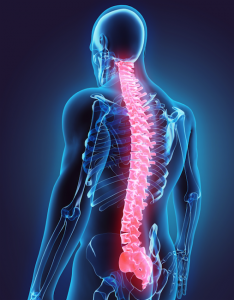Vertebroplasty
Back pain affects roughly 8% of the entire adult population. Back pain has many causes, some causes derive from genetics while others occur later in life. Back pain may occur due to degenerative changes or injury. 33 bones compose the spinal column. These bones, called vertebrae, can fracture due to injury or degenerative disease. More than 40 million americans may find themselves at risk of suffering a spinal fracture. Some characteristics may put an individual at a greater risk of developing a spinal fracture. Genetics, participating in certain sporting activities, and obesity may put an individual at a higher risk of suffering from a spinal fracture at some point in their lives. Physicians suggest that for each extra pound of weight that an individual carries, gravity places an extra seven pounds of pressure on to the spine. A procedure performed with the goal of relieving back pain, a Vertebroplasty consists of a spinal surgeon injecting special cement into the fractured vertebrae. Individuals should not confuse vertebroplasty with kyphoplasty. Doctors perform a kyphoplasty when the surgeon needs to create spaces between the vertebrae in addition to filling the spaces with cement.
Symptoms That May Indicate the Need For a Vertebroplasty
Symptoms of spinal fractures may vary depending on the location of the fracture and the cause of the fracture. Common symptoms of spinal fractures that patients report include:
- Neck or back pain
- Numbness or tingling
- Weakness or paralysis of muscles
- Muscle spasms
A variety of injuries or degenerative issues can cause these symptoms from vertebral fractures. The most common causes include automobile accidents, athletic activities, falls, and osteoarthritis.
How Do Physicians Treat Fractured Vertebrae Without a Vertebroplasty
Many spinal surgeons prefer more conservative approaches to back pain and spinal fractures since research has shown little benefit to a Vertebroplasty over conservative approaches. Conservative approaches include:
- Bed rest
- Non-Steroidal Anti-Inflamatory medication
- Pain Relievers and Muscle Relaxers
- Back Brace
- Physical Therapy
- Injections
Potential Risks or Complications of Vertebroplasty
Anytime a procedure involves penetrating the skin, risks and complications may occur. Complications of a Vertebroplasty procedure occur between 1 and 3% of all cases. While considered very low risk, patients may face risks or complications including:
- Hemorrhaging or blood loss
- Fever
- Infection
- Nerve Damage
- Issues with the cement
How Do Doctors Perform a Vertebroplasty
Prior to considering a patient for a Vertebroplasty, a spinal surgeon performs diagnostic testing. Diagnostic testing may include an x-ray, an MRI, or a CT scan. Diagnostic testing may also include all three of the previous listed types of diagnostics. Doctors use diagnostic testing in order to confirm suspected conditions To start the procedure, an anesthesiologist gives the patient a sedative or places the patient under general anesthesia. If given a sedative, the patient remains relaxed throughout the procedure and does not feel most of if any of the procedure. If the anesthesiologist places the patient under general anesthesia, the patient remains asleep throughout the procedure and does not feel anything. The anesthesiologist wakes the patient up once the surgeon completes the procedure. To perform the procedure, the spinal surgeon cleanses the area using an antibacterial solution. Next, the spinal surgeon uses a form of diagnostic called fluoroscope to continuously visualize where they guide the needle into the vertebrae. Once the surgeon identifies the correct vertebra, the surgeon fills the vertebra with the special cement. The vertebra may even require a second injection if the first injection does not suffice. Following the procedure, the patient must lie on their back for at least an hour to allow the cement to harden. A nurse observes the patient and check the patient’s vitals for 1 to 2 hours following the procedure. While some patients may feel immediate pain relief, others may take up to three days to feel the full benefits of a Vertebroplasty. The treating physician may recommend the patient to participate in physical therapy or potentially wear a brace. Physical therapy can help teach the patient exercises that do not hurt their back but still help strengthen the muscles that protect the back and spinal column.
not feel anything. The anesthesiologist wakes the patient up once the surgeon completes the procedure. To perform the procedure, the spinal surgeon cleanses the area using an antibacterial solution. Next, the spinal surgeon uses a form of diagnostic called fluoroscope to continuously visualize where they guide the needle into the vertebrae. Once the surgeon identifies the correct vertebra, the surgeon fills the vertebra with the special cement. The vertebra may even require a second injection if the first injection does not suffice. Following the procedure, the patient must lie on their back for at least an hour to allow the cement to harden. A nurse observes the patient and check the patient’s vitals for 1 to 2 hours following the procedure. While some patients may feel immediate pain relief, others may take up to three days to feel the full benefits of a Vertebroplasty. The treating physician may recommend the patient to participate in physical therapy or potentially wear a brace. Physical therapy can help teach the patient exercises that do not hurt their back but still help strengthen the muscles that protect the back and spinal column.
To view a list of all insurances that AOA Orthopedic Specialists accept, click HERE. To schedule an appointment online, click HERE.

